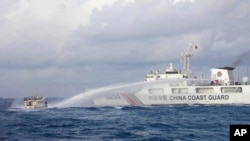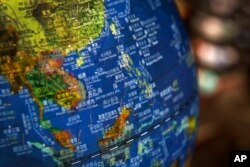The Philippines and China have been trading blame over a confrontation in the disputed waters of the South China Sea, where the two countries’ vessels clashed on December 10.
Known internationally as the Second Thomas Shoal, this submerged reef in the Spratly Islands is some 200 kilometers off the coast of the Philippines’ province of Palawan and about 1,285 kilometers from China’s southernmost Hainan Island.
Manila calls the disputed reef Ayungin Shoal, and Beijing calls it Renai Jiao.
The December 10 incident led to a dramatic escalation in the already tense bilateral relations.
The Philippines said that the Chinese coast guard had used water cannons against the civilian supply boats and a Philippine Coast Guard vessel that was escorting the mission.
The Chinese attack caused “severe damage” to the engine of one of the supply boats and damaged the mast of the coast guard vessel, the Philippines said.
China dismissed accusations and claimed it was the Philippines “stirring up trouble” and “infringing on China’s sovereignty.”
Chinese Foreign Ministry spokesperson Mao Ning said:
“The responsibility for the recent emergencies in waters of Ren’ai Jiao [Second Thomas Shoal] lies completely with the Philippines.”
The claim is misleading.
While Beijing baselessly claims sovereignty almost over the entirety of the South China Sea, this latest incident took place in the Philippines’ exclusive economic zone recognized as such by the U.N. International Tribunal’s 2016 ruling.
The Tribunal based its decision on the United Nations Convention on the Law of the Sea (UNCLOS), which defines an exclusive economic zone as a maritime area generally extending 200 nautical miles (230 miles) beyond a nation’s territorial sea, within which a coastal nation has jurisdiction over both living and nonliving resources.
Since the Second Thomas Shoal is less than 200 nautical miles from the western Filipino province of Palawan, UNCLOS therefore considers it part of the country’s exclusive economic zone. The ruling is legally binding, but the court has no power of enforcement.
China ratified the convention in 1996 and is legally obliged to adhere to the tribunal’s decisions. But Beijing refused to accept and disputed the Second Thomas Shoal ruling, claiming the international court violated “the principle of state consent” and “went beyond its authority to hear the case.”
This led to routine diplomatic and maritime skirmishes between the sides, with China becoming increasingly assertive in pressing its claims.
Beijing has been beefing up its military presence in the area, angering competing claimants including Vietnam, the Philippines, Taiwan, Malaysia and Brunei.
The U.S. supports the Philippines’ territorial claim on the Second Thomas Shoal.
The United Nations Conference on Trade and Development estimated in 2016 that one-third of the world’s maritime shipping passes through the South China Sea, accounting for $3.37 trillion in annual trade. The waters also hold large oil and natural gas reserves, and lucrative fisheries.
The December 10 attack targeted a supply mission for an aging World War II navy ship BRP Sierra Madre that the Philippines military deliberately grounded on the reef in 1999. A handful of navy troops guard the vessel to reinforce Manila’s sovereignty claims. They depend on the resupply missions for their survival and consider any attack on the ship as an act of war.
In the past, China has allowed food supplies to the BRP Sierra Madre, but carefully monitored whether the Philippines was transporting building materials to the shoal. In recent years, Beijing has been trying to change the status quo including by stepping up its efforts to block Philippines supply ships.







